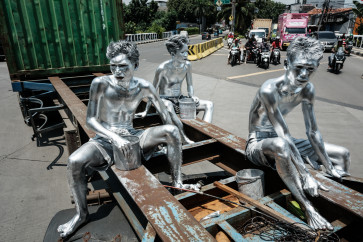Crystal fountain graces Pavilion
If you happen to be visiting Kuala Lumpur at this time of year, you are sure to be intrigued by the three gigantic bowls stacked at the entrance of Pavilion Kuala Lumpur
Change text size
Gift Premium Articles
to Anyone

I
f you happen to be visiting Kuala Lumpur at this time of year, you are sure to be intrigued by the three gigantic bowls stacked at the entrance of Pavilion Kuala Lumpur.
"Now, why would they want to put three enormous bowls at the center of a shopping center?" you wonder.
Try not to be too perplexed, because the 3.6-meter tall and six-meter wide fountain is in fact made of Liuli crystal, hand crafted for 18 months in Shanghai by the world famous glassware expert Liuligongfang and worth about RM8 million in total.
First revealed on the evening of July 4, 2009, the Malaysian Tourism Minister Ng Yen Yen stated in her speech that she expected the Pavilion Crystal Fountain to be the "new key landmark in Malaysia", putting it somewhat on a par with the world's tallest twin towers.
The fountain has also been included within the Malaysia Book of Records, acknowledging it as the tallest Liuli Crystal Fountain in Malaysia.
But why bowls? Well, why not?
According to design conceptualists, Pavilion KL and the masterminds behind Liuligongfang, bowls in Chinese culture have long symbolized fulfi llment and abundance, in which the exteriorly imprinted "Bloom of Hibiscus" - Malaysia's national fl ower - is a symbol of opulence, passion and progression.
The three bowls refl ect Malaysia's multicultural society that lives harmoniously in unity, while the way they are stacked asymmetrically upward signifi es the growing aspirations of the people.
The flow of water from all directions, on the other hand, means "endless blessing and prosperity for the nation," said the minister, adding that "the essence of this fountain is a refl ection of the Malaysian Prime Minister's "1 Malaysia" vision."
Minister Ng also did the symbolic gesture of tossing a coin into the bowls on the evening of July 4, emulating an old tradition that can be dated back to Roman-British and Celtic mythology.
As virtually any pool or fountain made accessible to the public qualifi es as a wishing well - and not just the Trevi Fountain of Rome -, try to keep in mind that "it's a long way to Rome".









